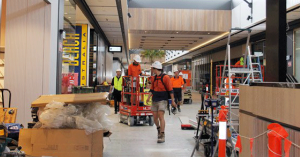Since the 2021 changes to the National Greenhouse Accounts (NGA) emissions factors, more building owners and operators are looking for ways to reduce their carbon footprint.
Now it is more important than ever to obtain a higher NABERS energy star rating and reduce operating and emissions costs as the Australian property sector shifts towards a more sustainable future.
There are two primary organisations that measure a building’s sustainability, NABERS (National Australian Built Environment Rating System) and Green Building Council of Australia. Both organisations provide first-rate benchmarks for building owners to measure, report and evaluate their energy efficiency. But what’s the difference between these two? And which energy rating system should you use?
If you’re looking for ways to improve the sustainability of your building, keep reading to see which of these organisations will best assist your needs.
What is NABERS?
NABERS is a rating system that measures a buildings water, electricity, waste, energy usage and indoor environment. It gives building owners and managers the tools to accurately measure the operational energy output of the facility.
The rating scale is 1-6 stars: 1 indicating the building’s energy usage is poor, and 6 indicating the building is at its highest efficiency. A good NABERS rating will increase the overall value of a building as it highlights where energy can be reduced, saving costs on power bills and improving the quality of the working environment. If you are leasing, subletting or selling a commercial space of 1000 square metres, it is a legal obligation that you have a NABERS certificate for the office.
Benefits
Evaluating the energy efficiency of your building each year with the NABERS benchmark will allow you to identify potential saving opportunities, make improvements on your previous strategies, and create new goals for annually reducing your carbon footprint.
By doing this, you’re ensuring the future of your building, achieving optimal performance and meeting high tenancy expectations. Having an accredited NABERS rating on your building will also give your building an advantage over its competitors, by indicating to the Australian property industry that your building’s sustainable initiatives are to a high standard.

What is Green Star?
The Green Building Council of Australia’s Green Star is a rating tool used to determine the sustainability of a facility’s fit outs and designs. It measures a building’s sustainability involving the built environment; this can be during the design, construction or fit out stage.
The Green Star also has six-star ratings: 1 being the lowest sustainability and 6 being world leading in sustainability. Having a Green Star rated building means building owners will follow the best sustainability standards with an asset designed to achieve high energy efficiency results. Green Star rated buildings produce around 55% less greenhouse gas emissions and send minimal waste to landfill during the building’s construction phase.
Benefits
Having a certified Green Star rating on your building’s design and fitouts will provide you the capability to ensure that your future operational costs will be low as your building is using less energy and producing less carbon.
The sustainability of your building will also work to keep employees comfortable and satisfied with a workplace that is healthier for them and the environment. The Green Star rating will demonstrate your commitment to high social and corporate responsibility, giving your building a competitive advantage, increasing the value of your building.
The difference?
Both energy rating systems are tools for building owners and operators to reduce their carbon footprint and save costs on energy consumption. NABERS provide energy ratings based on the productivity and usage of the building, focusing on the operational energy output.
While Green Star provides its star rating based on the level of sustainability of the facility’s built environment. Green Star measures the sustainability of the building’s design, while NABERS measures the sustainability of its operations.
Both share the same advantages of improving your building’s productivity and reducing operational costs, as well as improving the morale of your building’s occupants while ensuring a more sustainable future to benefit the environment.
How Alerton Australia can help
Contact Alerton Australia today and we can provide you with a valuable consultation on achieving Green Star points through building automation design and function. Ensure you’re meeting your energy saving targets where your savings can increase and your output can be reduced.
We can develop a comprehensive road map to guarantee you achieve your NABERS goals, with more than nine 6-Star Buildings and more than 70 5-Star buildings, we take a holistic approach to reducing your carbon output and improving your building’s performance and indoor environment.




